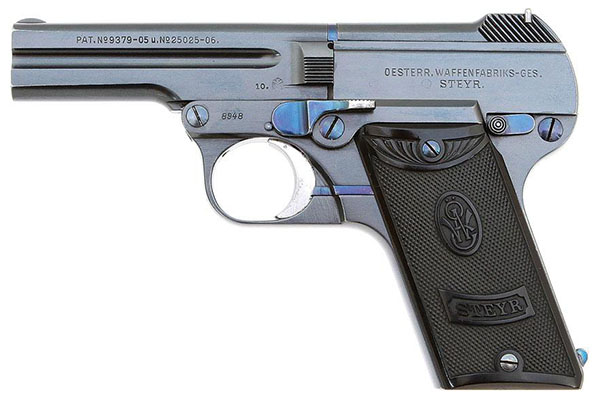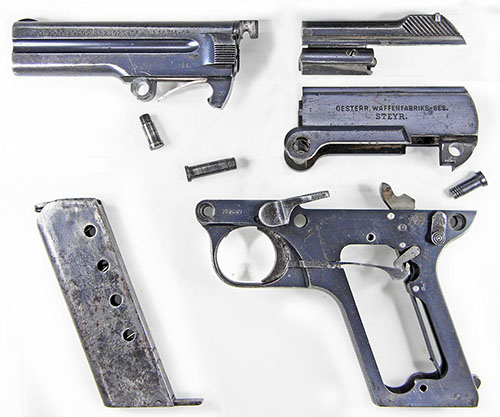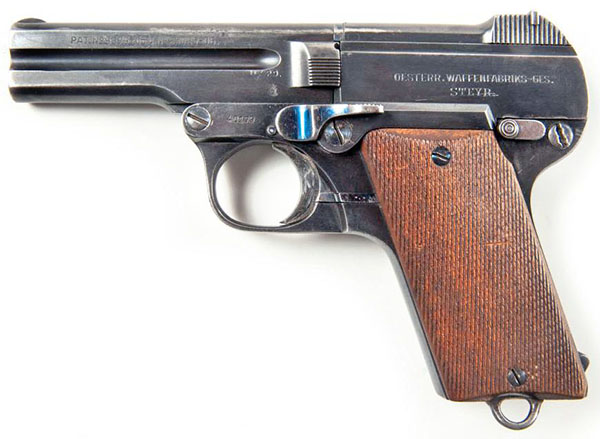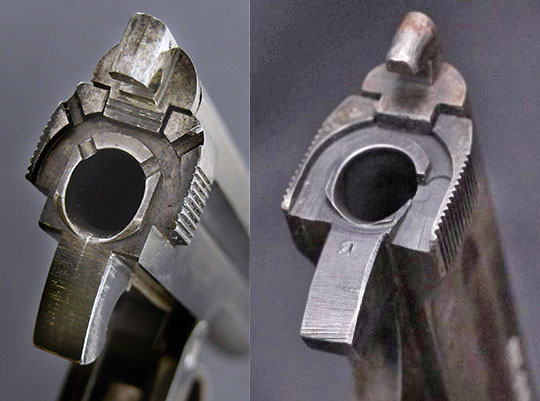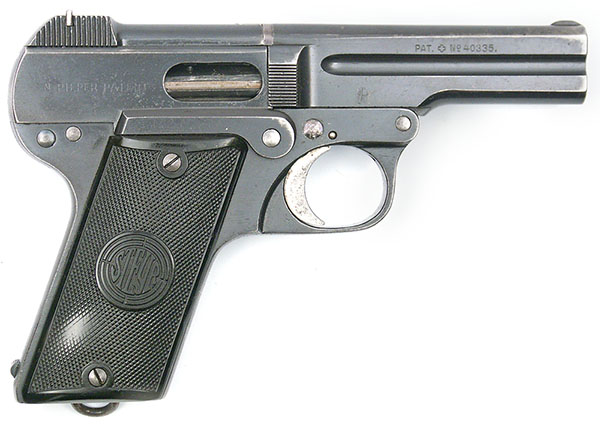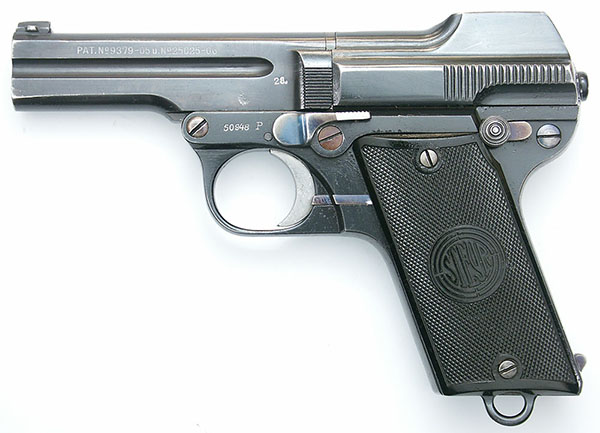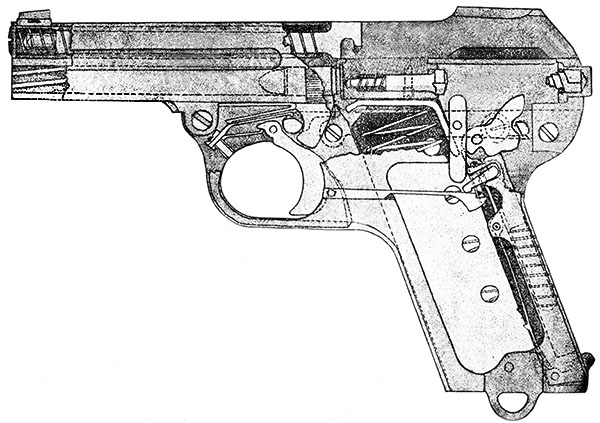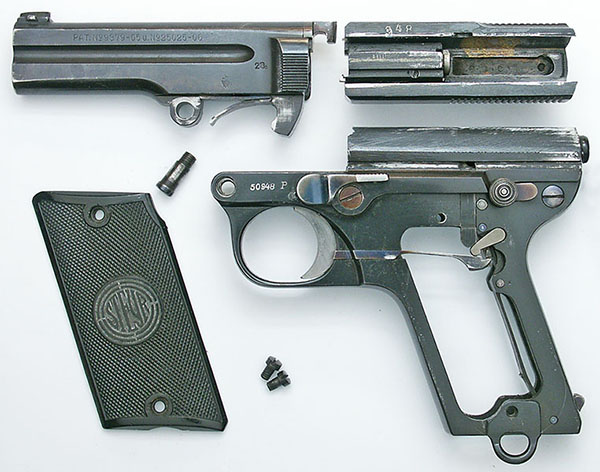 |
|||||||||||||||||||||||||||||||||||||||||||||||||||||||||||||||||||||||||||||||||||||||||||||||||||||||||||||||||||||||||||||||||||||||||||||
|
The 1909 Steyr Pieper Pistol by Dr. Stefan Klein and Ed Buffaloe
We will follow Mötz & Schuy’s classifications as much as possible, since they have covered these weapons in greater depth than anyone else. There are really only two major types, the Model 1909 and the Model 1934, but there are a number of minor variations. Older guns were often repaired or retrofitted with new features, and sometimes old parts were used to repair newer guns, complicating classification. The 7.65 mm Model 1909 Matthews states, without attribution: “The numbering of the 7.65 mm model is said to have started at 1001.” As of this writing, no three digit serial numbers are known. Mötz & Schuy state that most barrels were stamped with the two digit year of manufacture, which is not necessarily the same year in which the gun was proofed. Only guns intended for the internal market of Austria were actually proofed in Steyr, receiving the Vienna eagle proof on the left side of the barrel and the NPV mark on the right. Some early guns that were intended for the German market have German proofs and undated barrels.
The 7.65 mm Model 1909 Steyr Pieper is functionally identical in design to the Model 1909 First Series in 6.35 mm, except that it has an indicator in the rear of the upper receiver housing that
allows the shooter to determine, by sight or by touch, if the hammer is cocked. The upper receiver housing is fixed in the frame by two transvers
The safety lever turns 180°; when pointing to the rear, it locks the hammer; when pointing forward, the gun may be fired. The safety lever features circular grooves on the area where the thumb grasps
it. A drift-adjustable rear sight is set into the top of the upper receiver housing. There is a tiny half moon fixed front sight. The gripping surface of the attenuated slide has eleven angled triangular cut serrations. The Magazines hold seven cartridges and are found with four holes in a line near the spine. More scarce are magazines with seven staggered viewing holes—four near the spine and three in front. A few magazines may be found with five viewing holes near the spine, but are apparently rare. The left side of the upper receiver housing is marked in upper case characters: OESTERR. WAFFENFABRIKS-GES. The right side of the upper receiver housing is marked: N. PIEPER PATENT Early guns are stamped with two British patent numbers on the left side of the recoil spring housing, in upper case sans serif characters: PAT. № 9379-05. u. № 25025-06 Before the end of 1910 we begin to see a third British patent on the recoil spring housing: PAT. № 9379-05. № 25025-06. № 16715-08. The right side of the recoil spring housing is marked with the Swiss cross and an additional patent number: PAT.+ № 40335 The patents referenced are listed in Part I of this article. The finish is in rust blue, with fire blued barrel release lever, safety lever, transfer bar, screws, magazine release, and recoil spring guide rod latch. A few rare guns are known with a factory nickel finish. Grip stocks are of checked hard rubber with the ÖWG monogram in an oval near the top and the word STEYR in a curved banner beneath it. The serial number is stamped on the left side of the frame, above the trigger guard. The last three digits of the serial number are stamped on the bottom edge of the upper receiver housing and the bottom of the slide. Production of the first variant took place from 1909 through 1911. Mötz & Schuy document pistols manufactured in 1909, extending up to serial number 5770. If we assume that serial numbers began at 1001, maybe about 5000 guns were manufactured in 1909, leaving another 28,500 (approximately) that were manufactured in 1910 and 1911. If guns with three-digit serial numbers are ever identified, we can add 1000 to each of these figures. The 7.65 mm Model 1909/13, or M.13 The Model 1909/13 consists of nothing more than the addition of a lanyard loop to the bottom of the grip. The 7.65 mm Steyr was intended primarily for police and military use, and police and military often required lanyards on all handguns. The lanyard loop was added to the left side of the grip by inletting the left stock and affixing the lanyard to the grip frame. Many first variant guns were retrofitted with the lanyard both before and during World War I, and are now referred to as the Model 1909/13. The designation M.13 derives from the use of the gun with lanyard loop by the Austrian military. It is often applied to any gun with a lanyard loop. The 7.65 mm Model 1909/13-I In 1919, production of the 7.65 mm Steyr Pieper was resumed, and continued through 1922, with approximately 13,000 guns being made in this period. The primary change is that the grooves in the gripping surface of the slide are vertical instead of angled, making it somewhat easier to grasp; and all Model 1909/13-I guns feature a factory installed lanyard ring.
Early grip stocks remain the same, but many wooden stocks are found in the post-war period, due either to the scarcity of rubber or factory war damage. The wooden stocks were eventually superseded by checked hard rubber stocks with the new company logo, consisting of the word “Steyr” in a round stylized target. Recoil spring housings once again feature the two patent inscription of the early gun, omitting the 1908 patent: PAT. № 9379-05. u. № 25025-06 Mötz & Schuy state that the words MADE IN AUSTRIA were added to the left side inscription in this period, but we have been unable to identify an example of a 13-I with such an inscription. The 7.65 mm Model 1909/13-II - Hypothetical Variant Redesigned barrel, no extractor in the bolt. The Model 1909/13-II and -III are both hypothetical variants that likely only exist as prototypes or upgrades from earlier types, but were never production pistols. The Model 1909/13-II is characterized by the redesign of the breech of the barrel, providing greater reinforcement and extending the gripping surface at the rear of the barrel/recoil spring housing down to the bottom edge of the barrel. The breech face is also redesigned. The early breech face has vent grooves cut from the mouth of the barrel to each upper corner, allowing back pressure from the cartridge to bleed off. In the later breech face these grooves are eliminated and a cut is machined on the right side to accommodate the head of the extractor.
7.65 mm production resumed in 1928. Mötz & Schuy state that the redesigned barrel dates from this period; however, we have identified at least one barrel with a redesigned breech face that is dated 1922, so it is possible the change was made right at the end of 1922 production and was continued when production resumed in 1928. The few guns known to Mötz & Schuy in the 13-II configuration are guns that were repaired by replacing an old barrel with a new barrel. The 7.65 mm Model 1909/13-III - Hypothetical Variant Redesigned barrel, plus extractor, but retaining the loaded chamber indicator. This hypothetical variant would have the new barrel design plus an extractor in the bolt, and a loaded chamber indicator. There are no known guns with this configuration at the time of this writing. The 7.65 mm Model 1909/13-IV Redesigned barrel, plus extractor, no loaded chamber indicator. These guns, manufactured in 1928 and 1929 feature the new barrel design and an extractor in the bolt but lack the loaded chamber indicator in the upper receiver housing. They also feature a new slide inscription on the left side of the upper receiver housing: OESTERR. WAFFENFABRIKS-GES.
This variant is easily identified by the letter P as a suffix to the serial number. Mötz & Schuy state that they do NOT believe the P suffix indicates a gun intended for police use. Guns in the 13-IV configuration were made in a quantity of approximately 11,000, but many were later converted to the 1934 configuration. Problems with the 7.65 mm Model 1909 Mötz & Schuy state that the Austrian gendarmerie (federal police) and local police had widely adopted the Model 1909 and, by the mid-1920’s, with increased usage, a number of problems had become evident. The worst problems, unique to the Steyr Pieper, were:
Lesser problems, which are common to many automatic pistols, include:
Mötz & Schuy report that around 1926 the Vienna police introduced a low-power 7.65 mm cartridge “which was produced by G. Roth in Lichtenwörth and later by the Hirtenberger cartridge factory,” specially made for use in the Model 1909 and generating about 20% less pressure but, of course, its effectiveness was even worse than standard 7.65 mm Browning ammunition. By 1927, the military group investigating problems with the gun recommended that any remaining wooden buffers be replaced with rubber, only low-power ammunition be used, and magazines be stored empty. In 1933 the Austrian gendarmerie replaced its Model 1909 Steyr pistols with the Steyr Roth Model 1912; their Model 1909 pistols were passed on to border customs guards. The 7.65 mm Model 1934 (Model 1909/34)
In the Model 1934 the upper receiver housing and slide are completely redesigned, with the new slide being more than twice as heavy as the attenuated slide on the original Model 1909. The slide fully encloses the bolt, and runs on rails machined into the upper receiver housing. The new design provides the gun with an internal extractor that is not exposed to the elements. Additional improvements include a hardened ejector, a larger convex gripping surface on the manual safety lever, a conventional disconnector, and a more narrow barrel release lever. Finally, in place of the cocking indicator, there is a round recess in back of the upper receiver housing containing a steel truncated cone buffer spring.
The redesigned slide has a sighting groove at the rear. It was not possible to retain the adjustable rear sight because the new slide was too tall, so a new front sight platform is welded to the front of the old barrel and fitted with a dovetail to allow for an adjustable front sight tall enough to work with the rear sight groove. All Model 1934 pistols retain the lanyard loop. There are no inscriptions on the slide. The last three digits of the serial number are stamped on the bottom of the slide and on the upper receiver housing.
The redesign was intended as an upgrade for older guns, so they could remain in service. Virtually all of the Model 1934s are reconfigured Model 1909s, which is why they have dates much earlier than 1934. Actual production of new guns in the Model 1934 configuration only took place from 1940-1942 in very small numbers, with probably less than 1000 made, making them the rarest of the Steyr-Pieper pistols. Mötz & Schuy state that even these new production pistols often used old barrels and stocks, and so may be impossible to distinguish. Damaged parts in pistols being upgraded were replaced with available parts from old guns; some known examples contain parts from as many as three different weapons. The new upgrade was quite robust, and the weapon saw continued use in Austria into the mid 1960s, without further problems. The Model 1934 was eventually replaced with the Walther PP or PPK. Total Production If we assume serial numbers begin at 1001, total production of the 7.65 mm pistol is about 59,500. Evaluation While Warnant’s design is quite innovative, it was not fully thought out and its implementation was flawed. Back in the mid-1940s, Walter H. B. Smith produced an excellent summation of issues with the Model 1909 Steyr Pieper: While doing away with an [extractor] has advantages in that there are fewer parts, and less machining is required, there is a big disadvantage in that if the load happens to be weak or the recoil spring unusually strong, the gun may jam because of insufficient pressure within the empty case during rearward motion of the slide. In case of a misfire the cartridge is usually seated rather firmly in the firing chamber because of the pressure delivered to it by the blow of the firing pin. Before the weapon can be fired again, it is necessary to tip up the barrel and pry or punch out the misfired cartridge. Pulling back the slide, since there is no extractor, has no effect on the misfired cartridge in the chamber, but merely serves to bring another cartridge up into line with it and hopelessly jam the weapon. The bolt weighs 2.6 ounces. The recoil spring guide rod weighs an additional .7 of an ounce and must be considered as part of the recoiling member. Thus, it will be seen that the weight of the recoiling members is 3.3 ounces as against 8 ounces in the standard type of slide employed in the ordinary .32 automatic pistol. Due to the general construction, the recoil of this pistol is considerably heavier than that of most .32 automatics. In 2009, when I first tested the 6.35 mm and 7.65 mm Steyr pistols, I experienced several light hammer strikes with both guns. Possibly the cartridges had hard primers or the hammer spring was weak but, whatever the cause, I became well acquainted with design flaws in the Steyr Pieper. The stuck cartridges had to be pried out of the chamber with a screwdriver, just as Smith had described a half-century before me. Accuracy, especially with the 7.65 mm, was quite good at close range. I experienced some issues with cartridges not feeding, which were mostly corrected by a thorough cleaning and lubrication of the weapon, though weak magazine springs may also have been involved. The tiny grasping surface of the attenuated slide on both weapons made it difficult to retract. Even if the recoil spring is disconnected by tipping the barrel up, sometimes the slide gets stuck when pulled all the way to the rear (this can be alleviated by making a rubber stop buffer). And then there is the magazine... Smith does not mention issues involving the magazine but Pieper’s magazine design, with its baseplate extending to the rear, is truly bad. The release, which pushes against the baseplate to lever the magazine down, was a good idea, but then the release inevitably catches on the second detent for single shot fire. The shooter then has to engage the magazine release with one hand while pulling on the rear-facing baseplate with the other, but the rear-facing baseplate provides leverage in the wrong direction, so the shooter inevitably struggles with the normally simple operation of magazine removal. There is nothing to grasp at the front of the magazine to allow it to be easily withdrawn; hence a rapid reload is impossible. Hugh Pollard, in his 1921 book Automatic Pistols, states quite succinctly: “As single loaders they were not bad, but the magazine action was distinctly unreliable.” The Model 1934 upgrade solved most problems with the weapon, but the magazine issue was never addressed. |
|||||||||||||||||||||||||||||||||||||||||||||||||||||||||||||||||||||||||||||||||||||||||||||||||||||||||||||||||||||||||||||||||||||||||||||
|
|||||||||||||||||||||||||||||||||||||||||||||||||||||||||||||||||||||||||||||||||||||||||||||||||||||||||||||||||||||||||||||||||||||||||||||
|
Copyright 2009-2024 by Dr. Stefan Klein and Ed Buffaloe. All rights reserved. |
|||||||||||||||||||||||||||||||||||||||||||||||||||||||||||||||||||||||||||||||||||||||||||||||||||||||||||||||||||||||||||||||||||||||||||||
|
|
|||||||||||||||||||||||||||||||||||||||||||||||||||||||||||||||||||||||||||||||||||||||||||||||||||||||||||||||||||||||||||||||||||||||||||||
